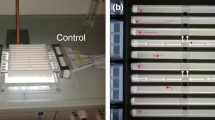Abstract
Adult Sitona lineatus L., (Coleoptera: Curculionidae) feed on the leaves of various species of leguminous plants, and females lay in the vicinity of pea plants, the roots of which are eaten by the larvae. A study of the volatiles from several legumes and of the response of S. lineatus individuals to these substances was undertaken using two complementary techniques: behavioral, to study the locomotory orientation; and electrophysiological, using electroantennography (EAG). Four volatile compounds, cis-3-hexen-1-ol, 2-hexenal, cis-3-hexen-1-yl acetate, and 3-octanone, were identified from pea, vetch, clover, and lucerne, by coupled gas chromatography–mass spectrometry (GC-MS) and coupled gas chromatography–infrared spectrometry (GC-IR). After emergence from July to mid-November, the imago display high response to the odor of pea and some other leguminous plants. A second period of enhanced sensitivity was observed during crop colonization from March to May. High EAG response to pea odor and cis-3-hexen-1-yl acetate was correlated with periods of enhanced locomotory orientation during these months. Experimental results indicate that cis-3-hexen-1-yl acetate could play a key role in discriminating pea among other acceptable leguminous species.
Similar content being viewed by others
REFERENCES
AUGER, J., and FERARY, S. 1994. Identification of allelochemicals and pheromones by combining GC/MS and direct deposition GC/FT IR. J. Chromatogr. 683:87–94
AUGER, J., LECOMTI, C., and THIBOUT, E. 1989. Leek odor analysis by gas chromatography and identification of the most active substance for the leek moth, Acrolepiopsis assectella. J. Chem. Ecol. 15:1847–1854
BLIGHT, M., and WADHAMS, L. J. 1987. Male-produced aggregation pheromone in pea and bean weevil, Sitona lineatus. J. Chem. Ecol. 13:733–739
BLIGHT, M., DAWSON, G. W., PICKETT, J. A., and WADHAMS, L. J. 1991. The identification and biological activity of the aggregation pheromone of Sitona lineatus. Aspects Appl. Biol. 27:137–142
BOWEN, M. F., DAVIS, E. E., and HAGGART, D. A. 1988. A behavioral and sensory analysis of host-seeking behaviour in the diapausing mosquito Culex pipiens. J. Insect. Physiol. 24:805–813
CHAIBOU, M. 1993. Aspects biologiques et électrophysiologiques de la communication olfactive chez Caryedon serratus. Relations intraspécifiques: La phéromone sexuelle et interspécifique: Les plants Hôtes. Thèse de Doctorat., Université F. Rabelais, Tours, France, 50 pp
DEJONG, R., and VISSER, J. H. 1988. Specificity-related suppression of responses to binary mixtures in olfactory receptors of the Colorado potato beetle. Brain Res. 447:18–24
FERARY, S., AUGER, J., and TOUCHE, A. 1996. Special potency of GC/MS and GC/direct deposition/IR combination in plant substances identification. Talanta 43:349–357
GUERIN, P. M., and VISSER, J. H. 1980. Electroantennogram responses of carrot fly, Psila rosae, to volatile plant components. Physiol. Entomol. 5:111–119
HANS, H. 1959. Contribution to the bionomics of Sitona lineatus. Z. Angew. Entomol. 44:343–386
HOFFMAN, A. 1963. Les Sitona, pp. 929–940, in A. S. Balachowsky (ed.). Entomologic Appliqué à l'Agriculture: T1, Coléoptères. Paris, 1391 pp
KENNEDY, J. S., and MOORHOUSE, J. E. 1969. Laboratory observation on locust responses to wind-borne grass odor. Entomol. Exp. Appl. 12:487–503
KOZLOWSKI, M. W., and VISSER, J. H. 1981. Host plant related properties of the antennal olfactory system in the oak flea weevil, Rhychaenus quercus. Electroantennogram study. Entomol. Exp. Appl. 30:169–175
LANDON, F. 1995. Biologie et écologie des adultes de Sitona lineatus L., ravageur du pois protéagineux Pisum sativum L. dans le Bassin Parisien. Thèse de Doctorat., Université d'Orléans, France, 219 pp
LANDON, F., LEVIEUX, J., HUIGNARD, J., and TAUPIN, P. 1995. Feeding activity of Sitona lineatus L. (Coleoptera, Curculionidae) on Pisum sativum L. (Leguminosae) during its imaginal life. J. Appl. Entomol. 119:515–522
LEXTRAIT, P., BIEMONT, J. C., and POUZAT, J. 1994. Comparison of walking locomotory reactions of two forms of Callosobruchus maculatus males subjected to female sex pheromone stimulation (Coleoptera: Bruchidae) J. Chem. Ecol. 20:2917–2930
LEXTRAIT, P., BIEMONT, J. C., and POUZAT, J. 1995. Pheromone release by the two forms of Callosobruchus maculatus females: Effects of age, temperature and host plant. Physiol. Entomol. 20:309–317
MOELLER, H. 1974. Untersuchungen über das Wirtswahlverlten und die Orientatierung von Sitona lineatus L. unter besonderer Berückschtigung olfaktorish und gustatorish bedirgter Verhalten-sweisen Universität Geissen, BRD, 99 pp
POUZAT, J. 1974. Comportement de la bruche du haricot femelle, Acanthoscelides obtectus Say (Col., Bruchidae) soumise à différents stimuli olfactifs (dont la plante hôte et le mâle). C. R. Acad. Sci. 278:2173–2175
SOKAL, R. R., and ROHLF, F. J. 1969. Biometry. The Principles and Practice of Statistics in Biological Research. W. H. Freeman and Co., San Francisco, 776 pp
THIERY, D., and VISSER, J. H. 1995. Satiation effects on olfactory orientation patterns of Colorado potato beetle females. C.R. Acad. Sci. Paris 318:105–111
VISSER, J. H. 1979. Electroantennogram responses of the Colorado beetle Leptinotarsa decemlineata to plant volatiles. Entomol. Exp. Appl. 25:86–87
WALLBANK, B. E., and WHEATLEY, G. A. 1976. Volatile constituents from caulitlower and other crucifers. Phytochemistry 15:763–766
Author information
Authors and Affiliations
Rights and permissions
About this article
Cite this article
Landon, F., Ferary, S., Pierre, D. et al. Sitona lineatus Host-Plant Odors and Their Components: Effect on Locomotor Behavior and Peripheral Sensitivity Variations. J Chem Ecol 23, 2161–2173 (1997). https://doi.org/10.1023/B:JOEC.0000006436.21448.b7
Issue Date:
DOI: https://doi.org/10.1023/B:JOEC.0000006436.21448.b7




